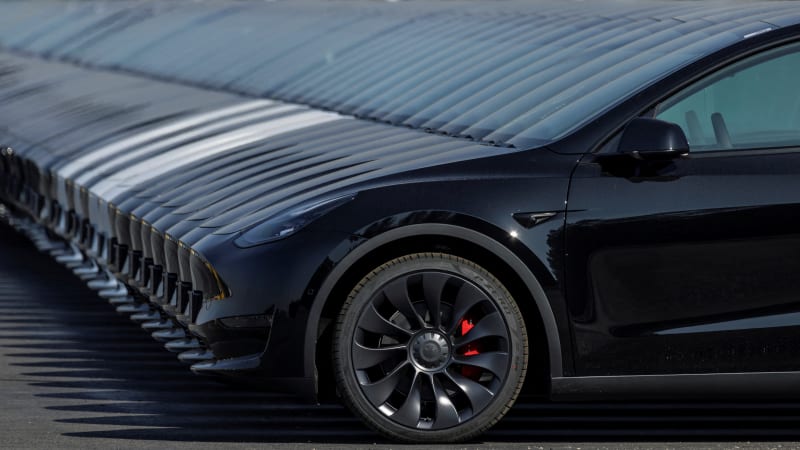How these top-selling electric cars could be affected by new tax credit

In a big win for Democrats, Senate passage of the Inflation Reduction Act brings the bill to the House, where the bill is expected to pass. If all goes as planned, the legislation could be in front of President Biden to sign in as little as a couple weeks.
For the automotive industry, a big piece of the legislation is the expansion of the $7,500 federal tax credit for EVs (electric vehicles), in which the cap on automakers to qualify for the credit — which currently is at 200,000 vehicles — will be removed. This means that Tesla and GM, which had been phased out, will again qualify.
While that sounds like good news for automakers, several requirements have now been introduced that have the automakers claiming 70% of EVs and PHEVs (plug-in hybrid EV) will not qualify for the credit.
“There are 72 EV models currently available for purchase in the United States including battery, plug-in hybrid and fuel cell electric vehicles, says John Bozzella, CEO of the Alliance for Automotive Innovation, a trade group that counts General Motors, Toyota, and Ford as members in a statement. “Seventy percent of those EVs would immediately become ineligible when the bill passes, and none would qualify for the full credit when additional sourcing requirements go into effect. Zero.”
These are the main requirements that will change and make the EV tax credits more restrictive:
Final assembly needs to take place in North America.
MSRP needs to be below $55,000 for cars, and below $80,000 for trucks and SUVs.
Battery material sourcing must be from the U.S. or its free-trade partners, to be phased-in. Batteries must have 40% content from those providers starting in 2024, and 100% by 2029. Right now, China dominates in EV batteries, with 76% of the market.
The final component of battery sourcing, coming in less than two years time, means no EVs will qualify for the credit, according to Bozzella. Note that these are just requirements on the automaker end; the bill adds income requirements on the consumer that will make many high-earning Americans and joint filers ineligible for the tax breaks.
The Automotive Alliance for Innovation lists all the zero emissions EV and PHEVs for sale in America here, along with a map and list of EV and battery manufacturers in America.
Along with that information and quarterly sales reports, Yahoo Finance has verified how the following cars, the top 5 selling EVs and PHEVs in America, will fare under the new rules.
Tesla Model 3 and Model Y
Both U.S.-made Model 3 sedans and Model Y SUVs, the top selling EVs in America, would qualify for the tax credit following passage, a boost for the brand because Tesla is currently phased out of the tax credit. (Note: Tesla does not break out sales between Model 3 and Model Y, but registration data is used as a proxy.)
However, only the lowest trim Model 3 Rear Wheel Drive qualifies (MSRP $46,990). As for the Model Y, both trims qualify (Long Range – $65,990; Performance – $69,990) assuming the government classifies the Model Y as an SUV.
Ford Mustang Mach-E
Coming in second in sales last quarter for EVs and PHEVs was the Ford Mustang Mach-E, with 10,941 units sold. With a starting MSRP of $43,895, the base Mach-E could qualify as a car or SUV, and because the Mach-E is assembled in Mexico, it actually would qualify for the tax credit.
Jeep Wrangler 4xE
The first plug-in hybrid on the list, the Wrangler 4xE, sold 10,861 units last quarter. With it most likely to be categorized as an SUV, and with a starting MSRP of $54,595, it would qualify for the tax break because the Wrangler is made at Jeep’s plant in Toledo, Ohio.
Hyundai IONIQ 5 and Kia EV6
The first non-U.S. brand on the list, the all-electric Hyundai IONIQ 5, which sold 7,448 units in the second quarter, and its sister brand Kia’s EV6 EV sold 7,287 cars. Though the Korean automaker does build cars in the U.S. at a plant in Alabama, the IONIQ 5 and Kia EV 6 are built in South Korea so they would not qualify for the tax credit. This is a blow for Hyundai as the IONIQ 5 and EV6 has been praised by reviewers, and start at a very competitive $39,950 and $33,900 respectively, though the relatively cheap MSRPs may still make both viable options for many Americans despite loss of the credit.
Chevrolet Bolt EV and EUV
GM’s entries on the top-sellers list, the Chevrolet Bolt EV and Bolt EUV, sold 6,945 units last quarter. With a starting price of $25,600, the Bolt is the cheapest pure electric vehicle on the market, and with final assembly taking place at GM’s Orion plant in Michigan, the Bolt will qualify for the federal tax credit.
Audi E-Tron, Lucid Air, Polestar 2, Porsche Taycan
Note that several popular, several sought-after models that currently qualify for the federal tax credit will not if the bill is signed into law — models such as the Audi E-Tron (country of assembly), Lucid Air (price), Polestar 2 sedan (country of assembly), and Porsche Taycan (price & country of assembly).
All is not lost for manufacturers however, as it may be possible the incentives will no longer be so important.
“By the time vehicle manufacturers can take full credit of the act, the market will be ready to accept electric vehicles and the incentives will no longer be necessary,” says Sam Fiorani, vice president of Global Vehicle Forecasting at AutoForecast Solutions in a statement to Yahoo Finance. “With or without the incentives, the price to the buyer will not change substantially. Incentives like these prop up the price and provide extra profits for the manufacturer.”



